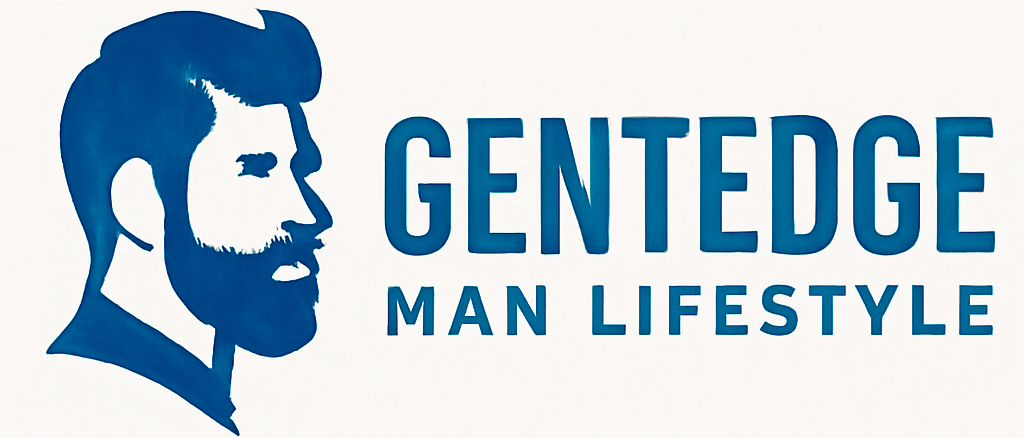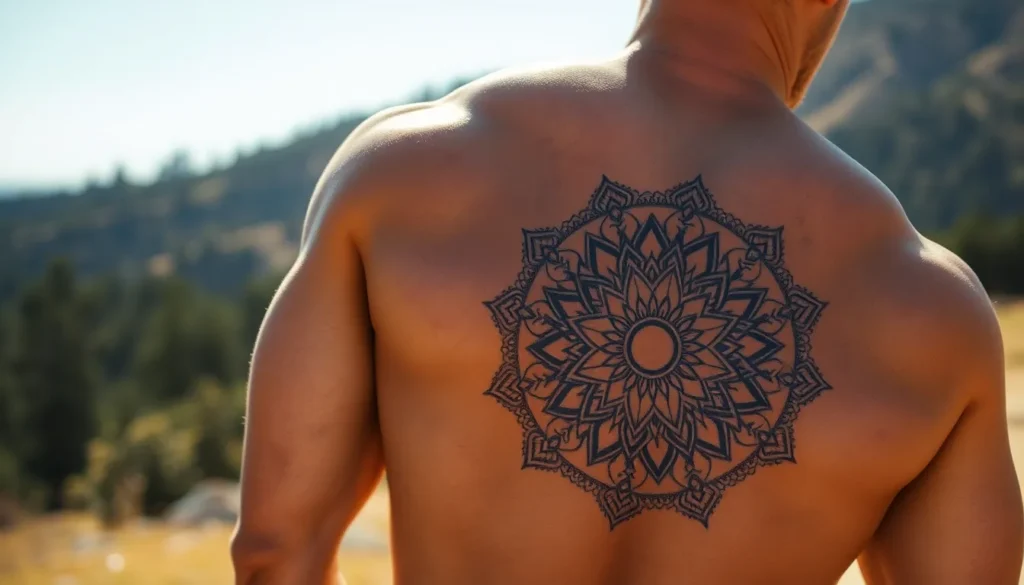We’ve witnessed an incredible surge in men choosing mandala back tattoos as their ultimate form of self-expression. These intricate geometric designs don’t just transform your back into a stunning canvas – they represent spiritual balance, personal growth, and masculine strength in ways that few other tattoo styles can match.
Bold geometric patterns flowing across broad shoulders and spine create an undeniably powerful visual impact that’s both meditative and striking. We’re seeing more men embrace these sacred circle designs because they offer endless customization options while maintaining deep symbolic meaning.
Whether you’re drawn to traditional Buddhist mandalas or modern geometric interpretations, we’ll guide you through everything you need to know about mandala back tattoos for men. From design inspiration to placement considerations, we’re here to help you make the perfect choice for your next major tattoo investment.
Understanding the Spiritual Significance of Mandala Back Tattoos for Men
These circular designs carry profound spiritual meaning beyond their visual impact. We’ll explore the deeper symbolism that makes mandala back tattoos particularly meaningful for men seeking spiritual connection through body art.
Sacred Geometry and Masculine Energy
Sacred geometry forms the foundation of every meaningful mandala back tattoo design. Mathematical precision in these patterns represents the ordered universe and divine masculine principles that resonate deeply with men. We find that triangular elements within mandalas symbolize strength and stability, while square patterns represent earthly foundations and grounded energy.
Masculine energy manifests through exact geometric arrangements in mandala tattoos. Angular lines and sharp corners channel assertive qualities, while interlocking patterns demonstrate leadership and protection instincts. Our research shows that men often gravitate toward mandalas featuring pronounced geometric borders that frame softer internal elements.
Balance between opposing forces creates the spiritual power in masculine mandala designs. Light and dark sections within the tattoo represent the duality of strength and compassion that defines modern masculinity. We observe that successful mandala back tattoos incorporate both rigid geometric structures and flowing organic elements to achieve this spiritual equilibrium.
Symmetrical patterns in mandala back tattoos reflect inner harmony and self mastery. Each mirrored element represents different aspects of masculine identity working in perfect coordination. We recommend designs that feature eight fold or twelve fold symmetry, as these numbers carry special significance in sacred geometry traditions.
Buddhist and Hindu Symbolism in Modern Tattoo Art
Buddhist symbolism in mandala back tattoos connects men to centuries of spiritual wisdom. The lotus flower elements represent rising above life’s challenges while maintaining inner purity. We see many clients choosing designs that incorporate dharma wheels or endless knots to symbolize their spiritual journey and interconnectedness with all life.
Hindu traditions contribute powerful masculine symbols to modern mandala tattoo designs. Om symbols integrated into mandala centers represent universal consciousness and divine masculine energy. We find that incorporating Sanskrit mantras around mandala borders adds personal spiritual significance while honoring ancient traditions.
Tibetan sand mandala concepts translate beautifully into permanent back tattoo art. These designs emphasize impermanence and spiritual transformation, themes that resonate strongly with men seeking personal growth. Our experience shows that clients who understand this symbolism develop deeper connections to their mandala back tattoos over time.
Modern interpretations blend traditional spiritual symbols with contemporary masculine aesthetics. Tribal elements mixed with Buddhist iconography create unique designs that honor both heritage and personal style. We encourage men to research the exact meanings of symbols they want to include, ensuring their mandala back tattoo authentically represents their spiritual beliefs and values.
Choosing the Perfect Size and Placement for Your Mandala Back Tattoo
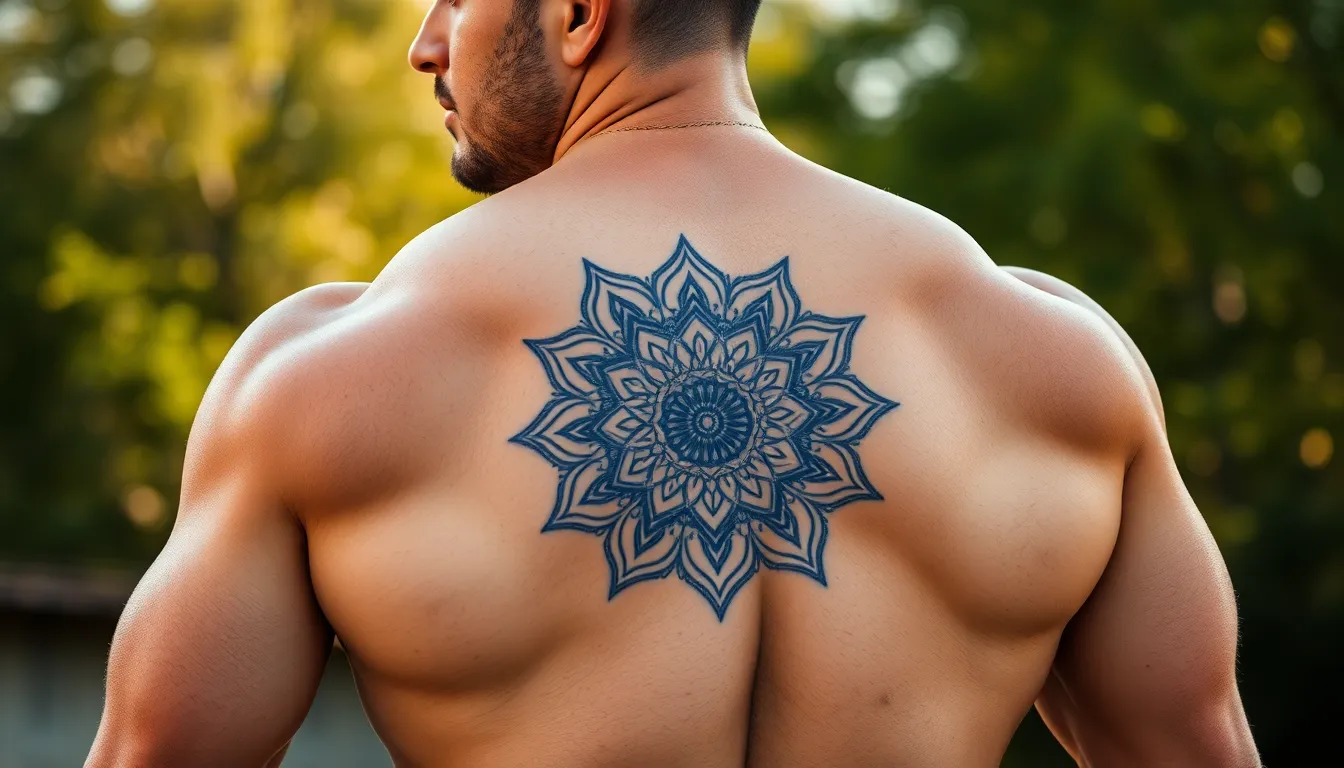
Once you’ve explored the spiritual significance of your mandala design, we need to focus on the practical decisions that’ll make your tattoo truly exceptional. Size and placement choices determine how your mandala flows with your body’s natural contours and how it’ll be perceived by others.
Full Back Coverage Versus Partial Back Designs
Full back mandala tattoos create bold, comprehensive statements that transform your entire back into a canvas for complex geometric patterns. We’ve observed that these extensive designs allow artists to incorporate intricate details and sophisticated shading techniques that flow naturally with your back’s contours. Complete coverage mandalas offer unlimited space for incorporating multiple symbolic elements while maintaining the balanced symmetry that’s central to mandala aesthetics.
Partial back designs focus artistic attention on exact areas like the upper back or shoulder blade region for men wanting detailed artwork without extensive coverage. We recommend partial mandalas when you’re looking for a meaningful tattoo that won’t require multiple lengthy sessions or important financial investment. These concentrated designs often highlight particular spiritual symbols or geometric patterns that hold special significance for your personal journey.
Size selection impacts both visual impact and practical considerations including session time, healing process, and long term maintenance. We’ve found that larger mandalas age better over time because they retain their boldness and clarity even as skin naturally changes. Smaller designs require more precise line work to maintain their intricate details throughout the years.
Upper Back Positioning for Maximum Visual Impact
Upper back placement offers the ideal surface for detailed mandala line work because this area provides a broad, relatively flat canvas that enhances geometric symmetry. We consistently recommend the upper back for men who want their mandala tattoo to serve as a striking visual centerpiece when shirtless or wearing tank tops. This positioning allows the design to flow naturally across your shoulder blades and trapezius muscles.
Visibility control becomes effortless with upper back mandalas since you can easily show or conceal your tattoo depending on your clothing choices. We appreciate how this placement offers professional flexibility while still allowing you to display your artwork during appropriate social situations. Upper back tattoos photograph exceptionally well and create impressive visual impact in fitness or beach settings.
Anatomical advantages make the upper back ideal for mandala symmetry because the relatively stable muscle structure in this area maintains design integrity over time. We’ve noticed that upper back tattoos experience less distortion from weight fluctuations or aging compared to other body areas. The natural shoulder blade contours can actually enhance certain mandala designs when incorporated thoughtfully into the overall composition.
Lower Back Placement Considerations
Lower back mandala tattoos provide more discreet placement options for men who prefer intimate or private body art that’s easily concealed. We understand that some men choose lower back positioning to create personal spiritual reminders that remain hidden during professional interactions. This placement works particularly well for smaller, focused mandala designs rather than extensive coverage pieces.
Anatomical challenges require careful design adjustments because the lower back’s natural curvature can affect how geometric patterns appear and flow. We recommend working with experienced artists who understand how to adapt mandala symmetry to complement your lower back’s unique contours. The curved surface may require modifications to traditional circular mandala formats to maintain visual balance.
Pain tolerance and healing considerations differ significantly in the lower back area compared to upper back placement. We’ve found that the lower back’s proximity to the spine can make tattooing more uncomfortable, though this varies greatly between individuals. Healing may take longer in this area due to clothing friction and sitting positions that can affect the tattoo during recovery periods.
Exploring Popular Mandala Back Tattoo Styles for Men
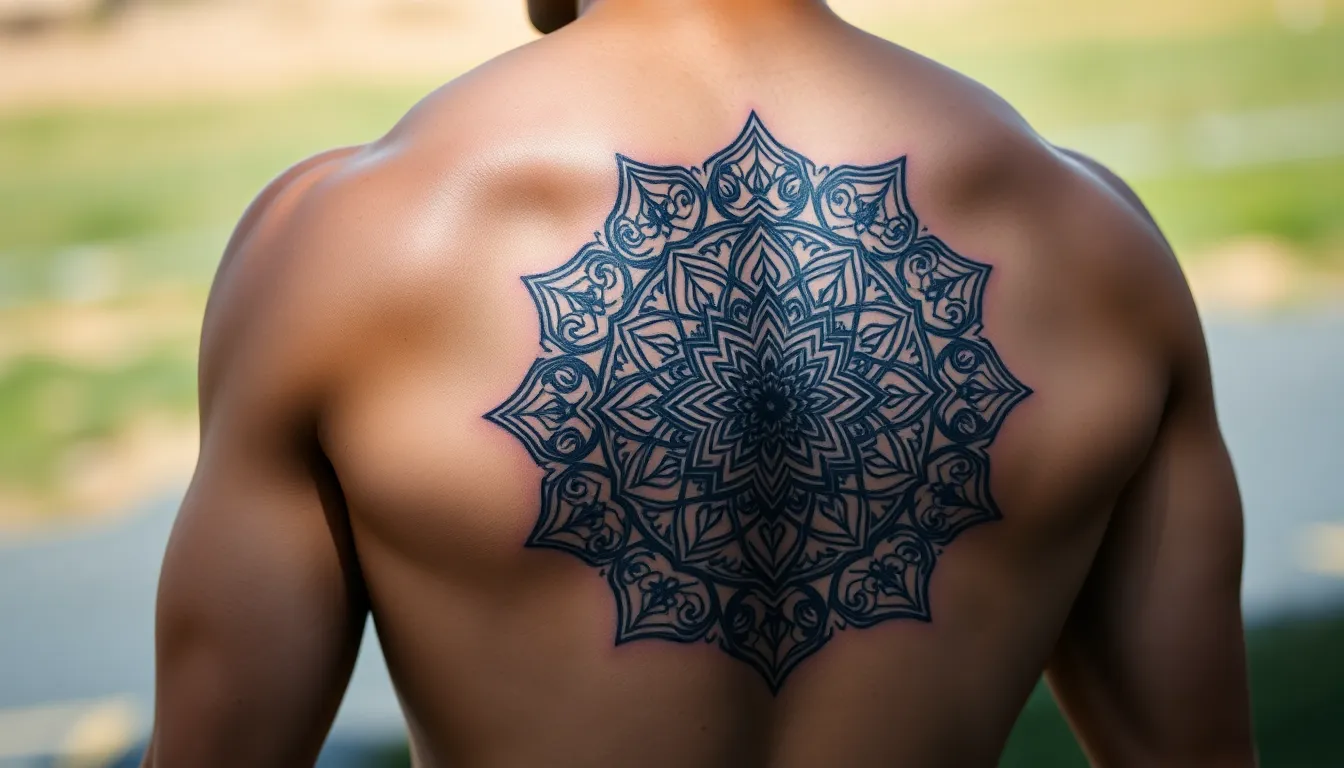
Different mandala styles offer unique aesthetic and spiritual elements that resonate with masculine preferences. We’ve identified three primary categories that consistently appeal to men seeking meaningful back tattoos.
Traditional Tibetan Mandala Designs
Traditional Tibetan mandala designs originate from Hindu and Buddhist traditions, symbolizing the universe and the path to enlightenment. These intricate circular patterns serve as spiritual tools for meditation and cosmic connection, making them ideal choices for men seeking deeper meaning in their body art.
Men who choose traditional Tibetan designs often express spirituality, inner peace, and self-reflection through these ancient cultural motifs. Complex geometric arrangements within these tattoos create sacred spaces that represent cosmic order and divine consciousness. Sacred symbols like the eight-spoked wheel and lotus petals frequently appear in these designs, each element carrying exact spiritual significance.
Artists typically use bold black lines and minimal color to maintain the authentic appearance of traditional Tibetan art. The circular structure provides natural boundaries that work perfectly with the back’s anatomy, creating balanced compositions that flow with the body’s natural curves.
Geometric Mandala Patterns with Sharp Lines
Geometric mandala patterns with sharp lines emphasize bold designs featuring sharp angles, thicker outlines, and symmetrical forms that convey strength and power. Blackwork styles are particularly popular, utilizing dark solid lines to enhance the visual impact of intricate geometric arrangements.
Masculine mandala tattoos often incorporate triangular elements that symbolize stability and masculine energy. Square patterns within the design represent grounded energy and foundation, while circular motifs maintain the traditional mandala structure. These geometric combinations evoke balance and harmony but with a robust and edgy appearance that aligns with masculine ideals of resilience and focus.
Contemporary artists frequently combine traditional mandala elements with modern geometric patterns, creating unique designs that bridge ancient symbolism with current aesthetic trends. Bold line work ensures these tattoos maintain their visual impact over time, making them practical choices for long-term body art investments.
Floral Mandala Combinations for Masculine Appeal
Floral mandala combinations adapt traditional flower motifs with darker colors and stronger lines to maintain masculine appeal. Though mandalas frequently include floral elements, masculine versions emphasize bold outlines and geometric structures to balance softer organic shapes.
The floral elements symbolize growth, life cycles, and natural beauty while combined with geometric or blackwork elements add an organic yet powerful dimension to the tattoo. Rose patterns often represent passion and strength, while lotus designs symbolize spiritual awakening and personal transformation. This fusion appeals to men seeking both softness and strength within their body art.
Artists achieve masculine floral designs by incorporating thorns, bold stem work, and angular leaf patterns that complement the geometric mandala structure. Dark shading techniques and strategic negative space create depth and contrast that enhances the overall masculine aesthetic while preserving the spiritual significance of floral symbolism.
Incorporating Complementary Elements Into Your Mandala Back Tattoo
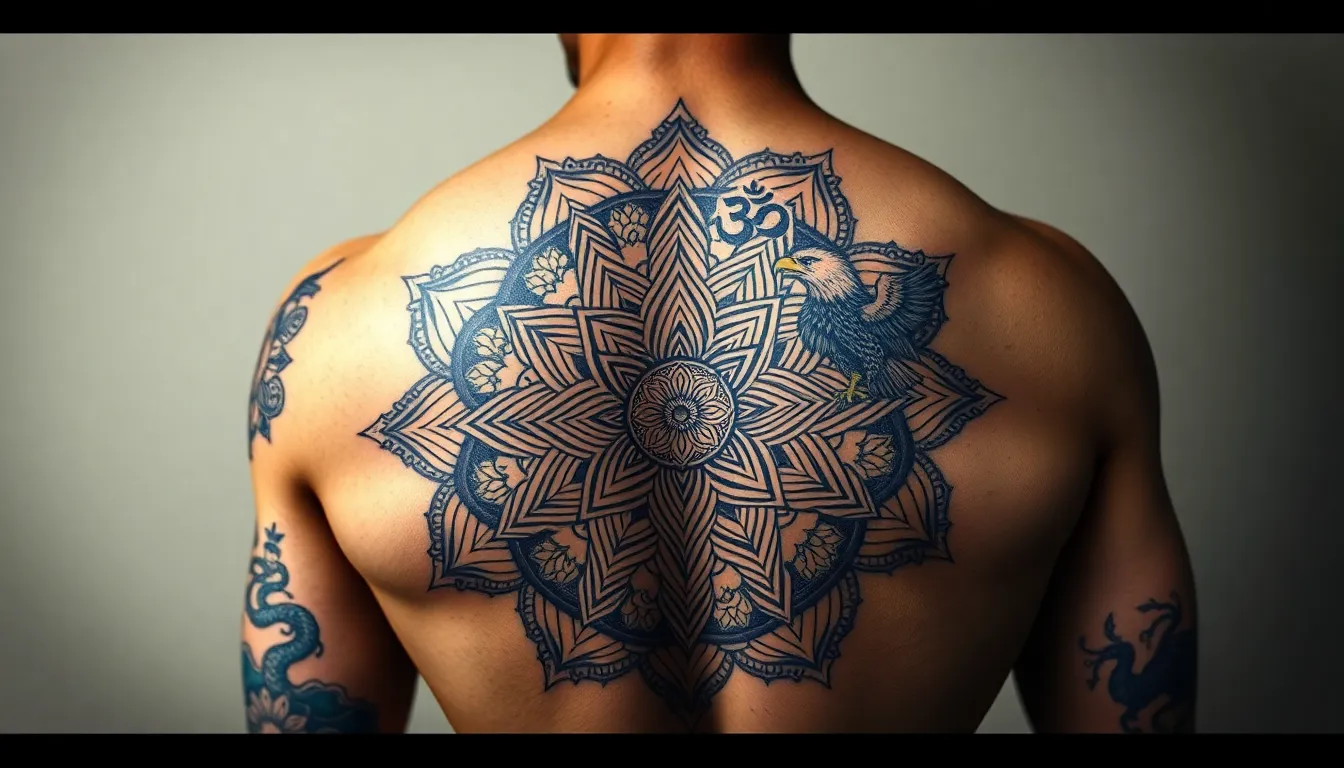
Building upon your chosen mandala style, we can enhance the spiritual depth and personal significance by weaving additional elements into the design. These complementary additions transform a beautiful geometric pattern into a deeply meaningful representation of your spiritual journey and masculine identity.
Animal Motifs and Spirit Guides
Lions represent courage and leadership, making them powerful additions to mandala back tattoos for men seeking to embody these qualities. We often see these majestic creatures positioned within or around the mandala’s outer rings, their manes flowing into the geometric patterns seamlessly.
Wolves symbolize loyalty and pack strength, resonating with men who value brotherhood and family bonds. These spirit animals work exceptionally well when integrated into the mandala’s lower sections, their howling silhouettes creating ever-changing contrast against circular patterns.
Dragons bring mythical power and protection to mandala designs, particularly appealing to men drawn to Eastern spiritual traditions. We recommend incorporating dragon elements as flowing lines that follow the mandala’s natural curves, creating movement within the structured geometry.
Eagles soar as symbols of freedom and vision, perfect for men seeking spiritual elevation through their tattoo art. These magnificent birds often appear at the mandala’s apex, their wings extending into decorative flourishes that enhance the overall composition.
Sacred Symbols and Religious Icons
Om symbols connect Hindu and Buddhist traditions to modern mandala tattoo art, representing universal consciousness and divine energy. We typically place these sacred marks at the mandala’s center, serving as the focal point from which all other elements radiate outward.
Crosses blend Christian symbolism with Eastern mandala traditions, creating unique spiritual fusions for men of diverse faiths. These religious icons work best when integrated subtly into the geometric framework rather than dominating the overall design.
Ankh symbols represent eternal life and divine protection, appealing to men interested in ancient Egyptian spirituality. We often incorporate these powerful symbols as vertical elements that anchor the mandala’s circular flow with strong linear components.
Yin yang emblems balance opposing forces within mandala designs, reinforcing themes of harmony and spiritual equilibrium. These complementary symbols enhance the mandala’s natural emphasis on balance while adding recognizable spiritual imagery.
Nature-Inspired Additions and Industry Elements
Lotus flowers symbolize spiritual growth and enlightenment, making them natural companions to mandala back tattoos. We integrate these sacred blooms as layered petals that echo the mandala’s concentric circles, creating organic softness within geometric precision.
Mountain ranges represent stability and permanence, grounding mandala designs with earthly strength and endurance. These industry elements work beautifully as background features that support the mandala without overwhelming its intricate details.
Ocean waves flow as symbols of life cycles and emotional depth, adding ever-changing movement to structured mandala patterns. We often incorporate wave motifs along the mandala’s outer edges, creating the impression of sacred geometry emerging from primordial waters.
Tree branches reach skyward as symbols of growth and connection, bridging earth and heaven within mandala compositions. These natural elements serve as perfect framework additions, their organic curves complementing the mandala’s mathematical precision while reinforcing themes of spiritual ascension.
Color Choices That Enhance Mandala Back Tattoos for Men
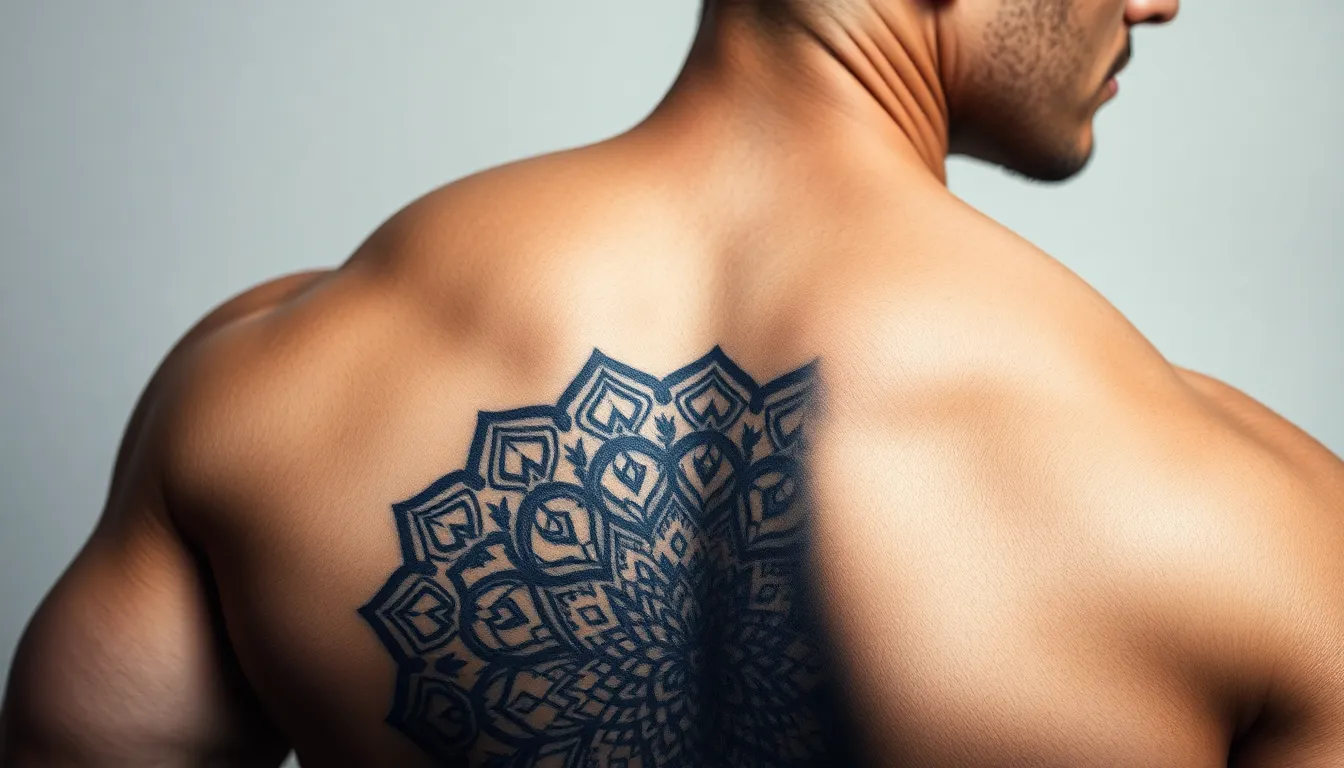
Color selection transforms mandala back tattoos from simple geometric patterns into powerful masculine statements. We’ll explore three distinct color approaches that complement the spiritual and aesthetic elements of these designs.
Bold Black and Gray Shading Techniques
Blackwork dominates the masculine mandala tattoo scene with its powerful visual impact and timeless appeal. Artists use thick, bold lines combined with varying tones of gray shading to emphasize intricate geometric patterns and create striking visual depth. This technique highlights the symmetrical geometry that defines mandala designs while lending a powerful, enduring look that enhances masculinity and clarity.
Shading variations create dimensional effects that make flat geometric patterns appear three-dimensional on the back’s curved surface. Master tattoo artists employ different needle configurations to achieve smooth gradients between deep blacks and lighter grays. These tonal contrasts emphasize the spiritual symbolism embedded within each mandala element, making sacred geometry more visually compelling and masculine.
Black and gray combinations age exceptionally well on the back’s larger canvas, maintaining their crisp appearance for decades. The monochromatic approach ensures that intricate details remain visible even as the tattoo naturally settles into the skin over time. This durability makes bold black and gray shading the preferred choice for men seeking lasting mandala artwork.
Vibrant Color Palettes for Eye-Catching Designs
Neo-traditional mandala tattoos incorporate vibrant colors that breathe fresh life into ancient spiritual symbols. Deep blues, rich reds, and metallic golds create eye-catching designs that stand out vividly against the back’s broad surface. These color palettes give traditional mandalas a modern twist while preserving their essential spiritual essence and masculine appeal.
Colorful mandalas symbolize vitality and personal transformation alongside their traditional spiritual themes. Artists strategically place bright colors to highlight exact mandala elements, such as lotus petals in deep purples or sacred geometry in brilliant oranges. This selective color application creates focal points that draw attention to the most meaningful aspects of the design.
Color saturation requires careful planning to ensure longevity and visual balance across the entire back piece. Professional artists consider skin tone, lifestyle factors, and long-term color retention when selecting vibrant hues. These considerations help maintain the tattoo’s impact and spiritual significance throughout the wearer’s lifetime.
Minimalist Single-Color Approaches
Minimalist mandala tattoos use single colors to maintain elegant simplicity while focusing on geometric precision and spiritual meaning. Black remains the most popular choice for this approach, creating understated but meaningful tattoos that emphasize personal harmony without overwhelming visual complexity. This style suits men who prefer refined, sophisticated body art that speaks quietly but powerfully.
Single-color designs highlight the mathematical precision inherent in mandala construction, allowing viewers to appreciate the geometric relationships and sacred proportions. The absence of color distractions focuses attention on line quality, symmetry, and the spiritual symbolism embedded within each geometric element. This approach creates a meditative quality that reflects the mandala’s original purpose as a tool for contemplation.
Simplicity enhances the mandala’s spiritual function as a visual mantra for inner peace and personal power. Men choosing this approach often seek tattoos that serve as private reminders of their spiritual journey rather than public displays of artistic complexity. The minimalist aesthetic creates a timeless quality that transcends tattoo trends and fashion cycles.
Finding the Right Tattoo Artist for Your Mandala Back Piece
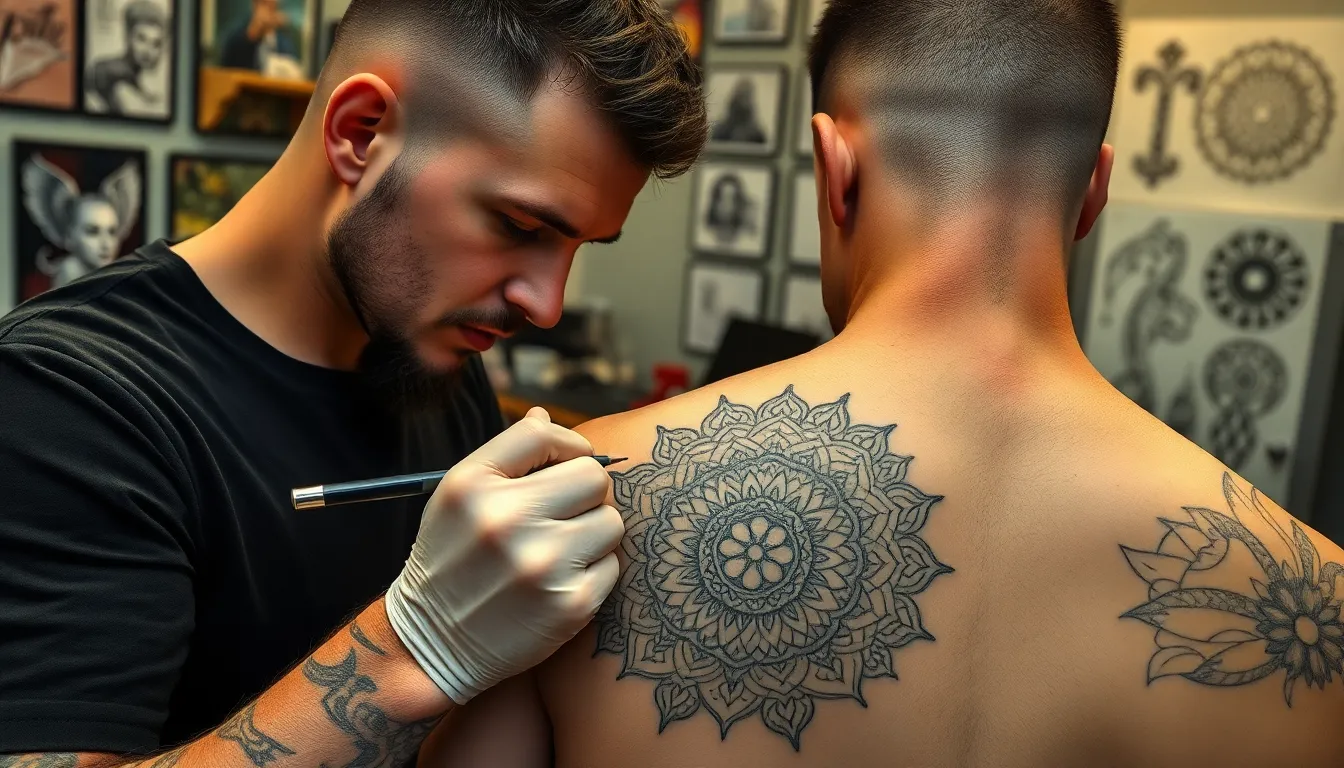
Selecting the perfect artist for your mandala back tattoo requires careful research and thorough evaluation. Your mandala design demands precision and expertise to achieve the spiritual and aesthetic impact you’re seeking.
Researching Artists Who Specialize in Geometric Designs
Look for artists who showcase mandala tattoos prominently in their portfolios. Geometric tattoo specialists understand the mathematical precision required for symmetrical patterns and sacred geometry. We recommend searching platforms like Pinterest and tattoo directories to identify artists whose work emphasizes clean lines and intricate details.
Check their experience with large scale back pieces specifically. Not every geometric artist has mastered the unique challenges of back tattoo placement and proportions. Artists specializing in mandala designs typically highlight their expertise through detailed portfolio sections dedicated to geometric work.
Examine their technical skills in creating perfect symmetry. Mandala tattoos rely heavily on balanced proportions and precise geometric patterns that require steady hands and mathematical understanding. Artists with geometric specialization demonstrate consistent line quality and pattern accuracy across their previous mandala projects.
Portfolio Review and Style Matching
Assess the complexity and flow of their previous mandala tattoos carefully. Portfolio review reveals an artist’s proficiency with intricate details and their ability to maintain design integrity across large surfaces. We suggest paying close attention to how they handle pattern transitions and geometric precision in completed pieces.
Match their artistic style with your desired aesthetic preferences. Some artists excel at bold, solid line work while others specialize in delicate, detailed patterns with subtle shading techniques. Your vision for the final design should align with the artist’s demonstrated strengths in mandala execution.
Evaluate their depth and dimensional techniques in geometric designs. Skilled mandala artists create visual depth through layering, shading, and pattern variation that brings sacred geometry to life. Look for examples showing how they achieve three dimensional effects within flat geometric patterns.
Consultation Process and Design Customization
Schedule a thorough consultation to discuss size, placement, and personal symbolism. The consultation process allows you to communicate your spiritual intentions and aesthetic preferences while the artist evaluates your back’s dimensions. Experienced artists collaborate with clients to refine designs that complement body shape and reflect personal meaning.
Discuss color choices and their emotional significance during design development. Colors influence your tattoo’s spiritual expression, with red representing passion and blue conveying calmness according to traditional mandala symbolism. Artists specializing in mandala work understand how color placement affects the overall energy and visual impact.
Expect multiple design revisions and sketching sessions before tattooing begins. Customization requires patience as artists develop personalized elements that make your mandala unique while maintaining traditional geometric principles. This collaborative process ensures your final design authentically represents your spiritual beliefs and aesthetic vision.
Preparing for Your Mandala Back Tattoo Session
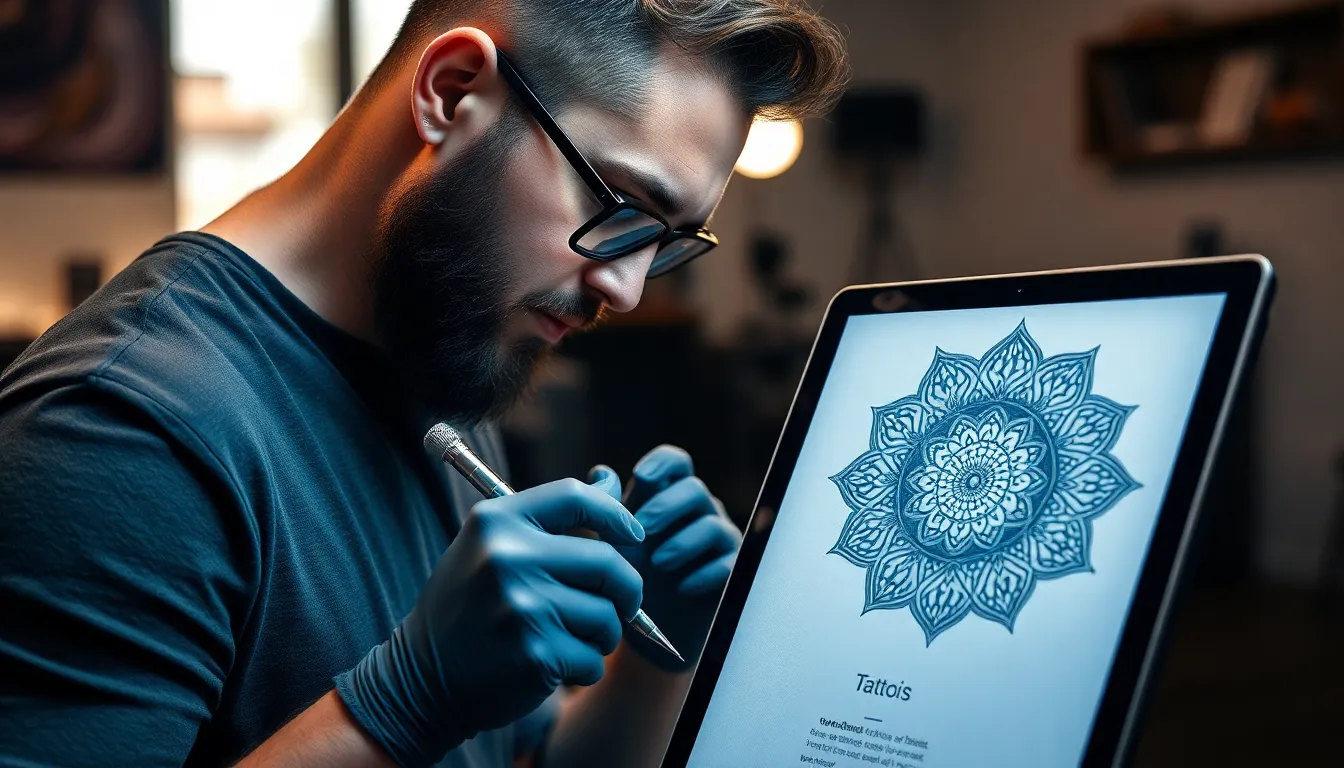
Once you’ve selected your artist and finalized your design, proper preparation becomes crucial for achieving the best results. We’ll guide you through the essential steps to ensure your mandala back tattoo experience is as smooth and successful as possible.
Physical Preparation and Pain Management
Getting your body ready for a mandala back tattoo session requires strategic preparation to minimize discomfort and optimize healing. We recommend staying well-hydrated in the days leading up to your appointment, as proper hydration helps your skin respond better to the tattooing process.
Eating a wholesome meal before your session provides the energy your body needs during what can be an extended tattooing experience. Avoiding alcohol or blood thinners for at least 24 hours before your appointment prevents excessive bleeding and helps the ink settle properly.
Pain levels vary significantly across different areas of your back, with the spine and shoulder blades being more sensitive due to their proximity to bones. The fleshy areas around your lower back typically cause less discomfort during the tattooing process.
Wearing loose, comfortable clothing allows easy access to your back while preventing irritation to freshly tattooed skin afterward. Discussing pain management options with your tattoo artist beforehand helps you prepare mentally and physically for the session.
Some men find numbing creams helpful, though we recommend consulting with your artist about their preferences and effectiveness. Taking regular breaks during long sessions prevents fatigue and helps maintain your pain tolerance throughout the process.
Multiple Session Planning and Timeline
Large mandala back tattoos almost always require multiple sessions to achieve the precision and detail these intricate designs demand. Sessions typically range from 3 to 6 hours depending on the design’s complexity and your individual tolerance levels.
Scheduling several weeks between sessions allows your skin to heal completely and reduces overall discomfort for subsequent appointments. We suggest planning for a timeline that spans several months, especially for highly detailed or colored mandala designs.
Breaking your tattoo into manageable sections prevents artist fatigue and ensures consistent quality throughout the entire piece. Your artist will typically start with the outline during the first session, then add shading and details in subsequent appointments.
Colored mandala tattoos often require additional sessions beyond black and gray designs due to the layering process needed for vibrant, lasting colors. Planning flexibility into your schedule accommodates potential adjustments to session timing based on your healing progress.
Communication with your artist about your timeline expectations helps create a realistic completion schedule that works for both parties. Rushing the process compromises the final result, so patience during this phase proves essential for achieving your desired outcome.
Aftercare Essentials for Large Back Pieces
Caring for a large mandala back tattoo requires diligent attention to detail and consistency throughout the healing process. We recommend using a mild, fragrance-free antibacterial soap to gently cleanse the area without causing irritation.
Applying tattoo-exact healing ointment or fragrance-free moisturizer multiple times daily prevents dryness and cracking that can damage your artwork. Keeping the tattoo clean and dry between moisturizing sessions reduces the risk of infection.
Protecting your fresh tattoo from direct sunlight prevents fading and painful burning during the vulnerable healing period. Avoiding swimming or submerging the tattoo in water until fully healed prevents bacterial infections and ink loss.
Wearing loose, breathable clothing prevents pressure and friction against your healing tattoo, which could cause scabbing or color loss. Cotton fabrics work best as they allow air circulation while minimizing irritation.
Following your artist’s exact aftercare instructions proves crucial since individual recommendations may vary based on their techniques and your skin type. Monitoring your tattoo for signs of infection or unusual healing patterns helps address any issues quickly before they become serious problems.
Mandala Back Tattoo Maintenance and Long-Term Care
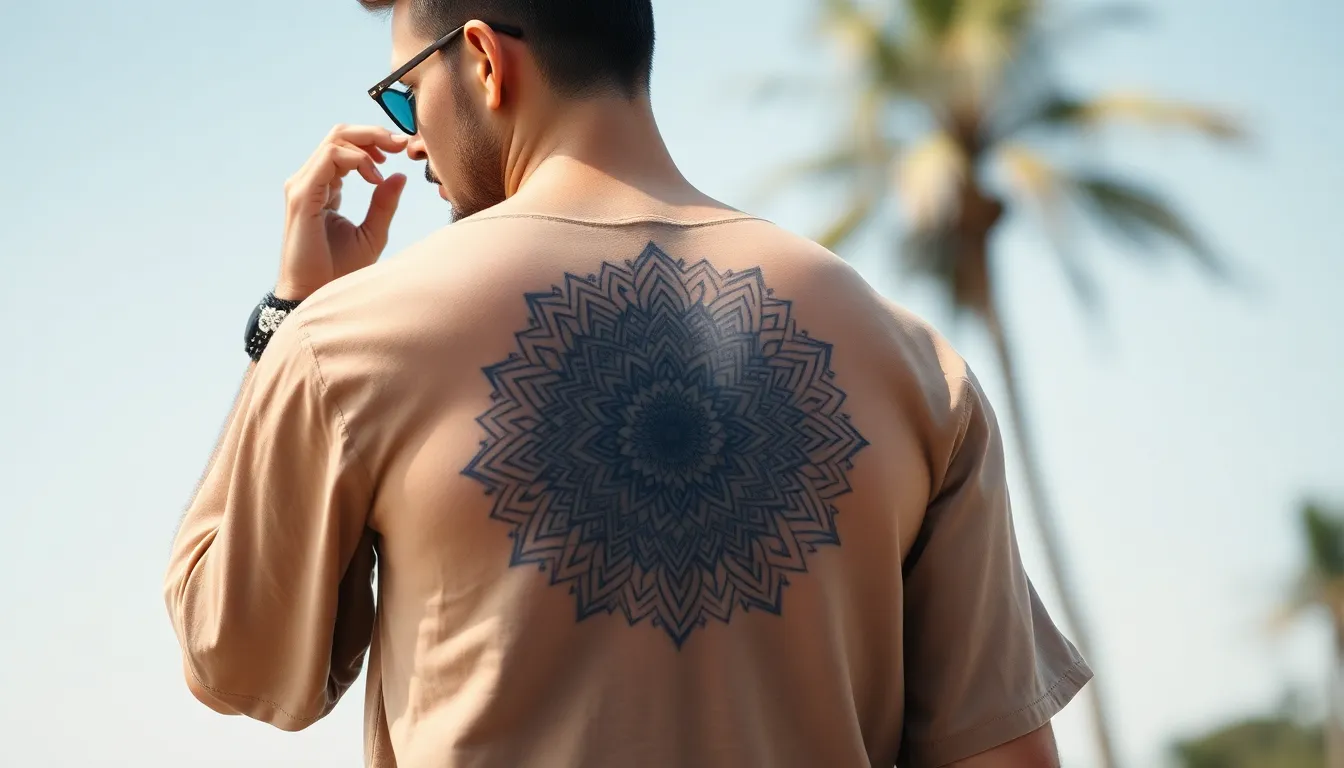
Your mandala back tattoo’s intricate geometric designs require dedicated maintenance to preserve their spiritual significance and visual impact. We’ll guide you through essential care practices that protect your investment and maintain the tattoo’s powerful symbolism for years to come.
Protecting Your Investment from Sun Damage
Sun protection stands as the most critical factor in maintaining your mandala back tattoo’s vibrant appearance and intricate details. UV rays systematically break down tattoo ink molecules, causing the bold geometric patterns and sacred symbols to fade and lose their spiritual impact over time.
High SPF sunscreen becomes your daily ritual when your tattoo is exposed to sunlight. We recommend applying broad spectrum SPF 30 or higher to the entire tattooed area, reapplying every two hours during outdoor activities. Quality sunscreens create a protective barrier that prevents UV penetration and preserves the darker shades that express masculine strength and stability.
Clothing choices significantly impact your tattoo’s longevity and appearance. Loose fitting, breathable fabrics reduce friction against the healing skin while blocking harmful rays naturally. Cotton and bamboo materials allow proper air circulation without creating irritation that could damage the precise geometric lines and sacred patterns.
Strategic wardrobe planning protects your mandala design during peak sun hours between 10 AM and 4 PM. Long sleeved shirts or lightweight cover ups provide complete protection while maintaining comfort during outdoor activities and work environments.
Touch-Up Scheduling and Color Preservation
Regular touch ups maintain the crisp lines and vibrant colors that make mandala back tattoos so visually striking. Intricate geometric designs require professional attention every 5 to 7 years to preserve their spiritual symbolism and artistic integrity, particularly in areas where skin naturally stretches and moves.
Monochromatic mandalas in black or gray typically need less frequent maintenance than colorful designs but still benefit from periodic line work to retain depth and contrast. These classic color choices age gracefully while maintaining their connection to traditional Buddhist and Hindu spiritual practices.
Color preservation depends heavily on the exact palette chosen for your design. Bold blues, reds, greens, yellows, and purples each carry unique symbolic meanings and emotional impacts that require different maintenance approaches. Warmer colors like reds and yellows tend to fade faster than cooler blues and greens, necessitating more frequent touch up sessions.
Professional assessment determines the optimal timing for touch up work based on your tattoo’s current condition, skin type, and lifestyle factors. Experienced artists can identify areas needing attention before important fading occurs, preserving the mandala’s spiritual significance and visual power.
Lifestyle Adjustments for Optimal Healing
Skin hydration forms the foundation of proper mandala tattoo care during the critical healing phase. Fragrance free, hypoallergenic lotions keep skin elastic and support optimal ink retention, ensuring your sacred geometric patterns maintain their intended appearance and spiritual meaning.
Activity modifications protect your healing tattoo from damage during the first 2 to 4 weeks. Avoid prolonged sun exposure, excessive sweating from intense workouts, and tight clothing that creates friction against the delicate tattooed skin. Swimming pools, hot tubs, and saunas should be avoided until complete healing occurs.
Cleanliness protocols prevent infection and promote optimal healing outcomes for your intricate mandala design. Gentle washing with antibacterial soap twice daily, followed by thorough patting dry with clean towels, creates the ideal environment for proper skin recovery and ink stabilization.
Sleep positioning considerations become important during healing, especially for large back pieces that cover important surface area. Sleeping on your stomach or side may cause bedding friction against fresh tattoo work, potentially affecting line quality and color saturation in your mandala’s geometric patterns.
Dietary choices support skin health and healing processes that directly impact your tattoo’s long term appearance. Adequate protein intake, vitamin C, and zinc consumption promote collagen production and tissue repair, while staying properly hydrated maintains skin elasticity and supports vibrant ink retention throughout the healing process.
Cost Considerations for Mandala Back Tattoos for Men
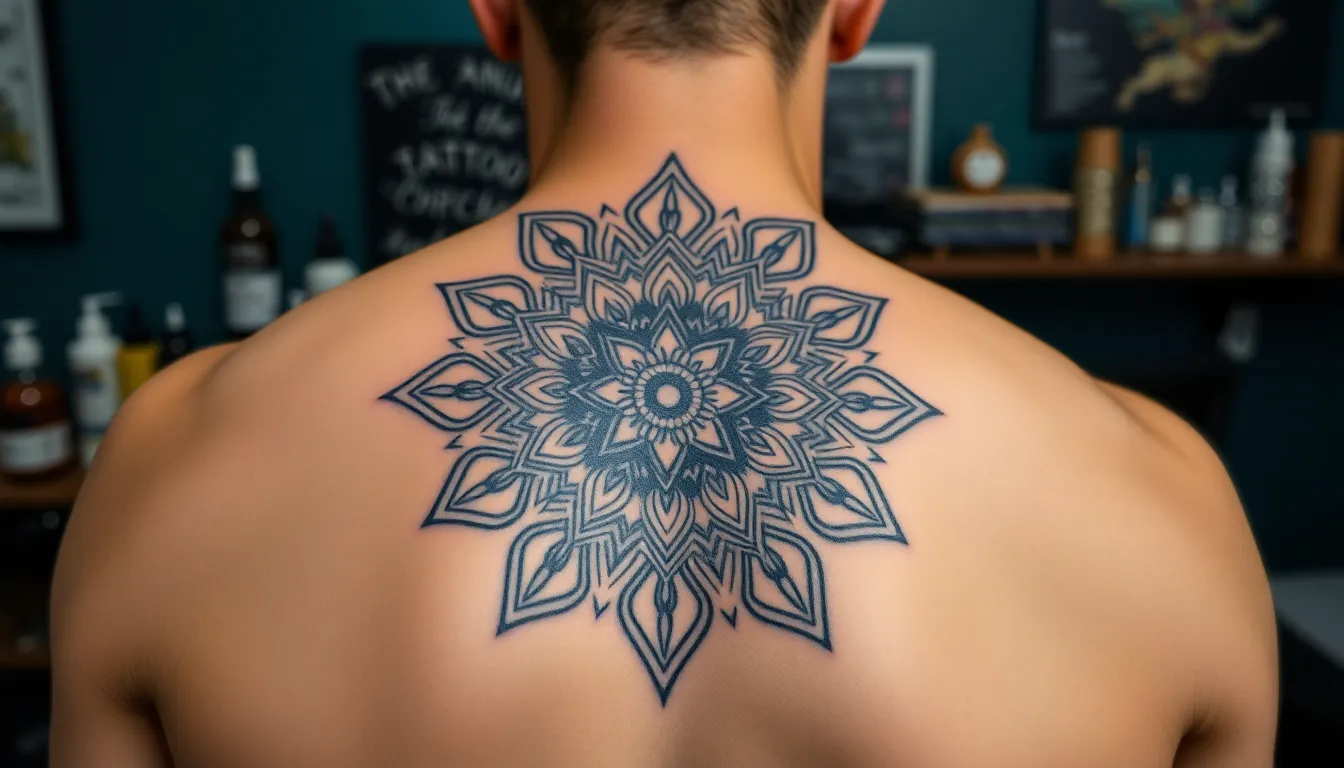
Before committing to your mandala back tattoo, we need to discuss the financial investment required for this spiritual body art. Understanding the various cost factors helps us make informed decisions and avoid surprises during the process.
Pricing Factors for Large-Scale Designs
Size directly impacts your overall investment since back tattoos typically span large areas to accommodate intricate mandala patterns. Most mandala back pieces measure over 12 inches, requiring significantly more time and ink than smaller designs.
Design complexity elevates costs substantially because mandalas demand precise geometric patterns and perfect symmetry. Artists spend additional hours ensuring each line, dot, and curve aligns correctly with the sacred geometry principles.
Artist experience determines your session rates as skilled professionals charge premium prices for their expertise. Reputable artists specializing in geometric designs often charge $150 to $300 per hour for complex mandala work.
Studio location affects pricing structures since major urban areas typically charge higher rates due to increased overhead costs. Cities like New York, Los Angeles, and Chicago command premium prices compared to smaller towns.
Budgeting for Multiple Sessions
Multiple sessions become necessary for comprehensive mandala back tattoos since these designs can’t be completed in single appointments. Large-scale pieces require 3 to 6 sessions spaced 4 to 6 weeks apart for proper healing.
Each session costs several hundred dollars depending on the artist’s hourly rate and session length. We typically see individual sessions ranging from $400 to $800 based on complexity and duration.
Planning for cumulative expenses means budgeting for the total project cost rather than single session prices. Additional costs include consultation fees, aftercare products, and gratuities for your artist.
Timeline considerations impact your budget since spreading payments across multiple months makes the investment more manageable. Most clients find it easier to budget $500 to $1,000 per month rather than paying everything upfront.
Quality Versus Affordability Balance
Choosing cheaper options compromises design precision and may result in poorly executed geometric patterns that lack the spiritual significance you’re seeking. Mandala tattoos require exceptional technical skill that budget artists often can’t provide.
Investing in skilled artists ensures proper execution of intricate details and perfect symmetry crucial for mandala designs. According to pricing estimates, experienced artists charge approximately $770 to $1,000 for large mandala tattoos over 12 inches.
Prioritizing quality prevents costly corrections since poorly executed mandalas often require expensive cover-ups or laser removal. We’ve seen clients spend twice the original amount fixing subpar work.
Researching artist portfolios saves money long-term by helping you identify professionals who specialize in geometric designs. Artists with proven mandala experience deliver better results that maintain their visual impact over time.
Conclusion
We’ve explored the profound journey of mandala back tattoos for men – from their deep spiritual roots to the practical considerations that make them successful. These powerful designs offer more than just visual impact; they represent a commitment to personal growth and spiritual expression that resonates with men seeking meaningful body art.
The path to your perfect mandala back tattoo requires thoughtful planning and the right artistic partnership. We’ve covered everything from sacred geometry and symbolic elements to artist selection and long-term care because each aspect contributes to the final masterpiece.
Your mandala back tattoo will become a lifelong companion that evolves with you spiritually and aesthetically. With proper preparation care and maintenance it’ll remain a vibrant testament to your personal journey for years to come.
Frequently Asked Questions
What do mandala back tattoos symbolize?
Mandala back tattoos symbolize spiritual balance, personal growth, and masculine strength. They represent the ordered universe through sacred geometry, with triangular elements symbolizing strength and square patterns representing grounded energy. These designs often incorporate Buddhist and Hindu symbolism, including lotus flowers and Om symbols, to express universal consciousness and personal transformation.
How much do mandala back tattoos typically cost?
Mandala back tattoo costs vary based on size, design complexity, artist experience, and studio location. Larger designs require more time and ink, increasing costs significantly. Most comprehensive mandala back pieces require 3-6 sessions, with prices ranging from hundreds to thousands of dollars. It’s essential to prioritize quality over affordability to avoid costly corrections later.
How long does it take to complete a mandala back tattoo?
Large mandala back tattoos typically require multiple sessions spanning 3-6 appointments. Each session can last 4-8 hours depending on design complexity and pain tolerance. Full back coverage designs may take several months to complete, allowing proper healing time between sessions. The timeline depends on design intricacy, size, and individual healing speed.
What’s the difference between upper and lower back placement?
Upper back placement provides maximum visual impact with a broad canvas that enhances geometric symmetry and allows easy visibility control. Lower back placement offers more discreet options but presents anatomical challenges requiring careful design adjustments. Pain tolerance and healing considerations differ significantly, with upper back generally being more manageable for large designs.
How do I choose the right tattoo artist for my mandala design?
Look for artists specializing in geometric designs with experience in large-scale back pieces. Review their portfolios for technical skills, line work precision, and style compatibility. Schedule consultations to discuss size, placement, symbolism, and color choices. Prioritize artists with strong geometric tattooing backgrounds and positive client reviews for complex mandala work.
What should I expect during the healing process?
Mandala back tattoos require 2-4 weeks for initial healing, with complete healing taking 2-3 months. Expect some swelling, redness, and peeling during the first week. Follow aftercare instructions including gentle washing, moisturizing, and avoiding sun exposure. Large designs may heal in sections, requiring careful attention to prevent infection and ensure proper color retention.
Can mandala back tattoos be customized with personal elements?
Yes, mandala back tattoos are highly customizable. You can incorporate animal motifs like lions or wolves, sacred symbols such as Om or crosses, and nature elements like lotus flowers or mountain ranges. Work with your artist to blend personal symbolism with traditional mandala geometry while maintaining the design’s spiritual significance and visual balance.
How do I maintain my mandala back tattoo long-term?
Protect your tattoo from sun exposure using high SPF sunscreen and appropriate clothing. Keep skin hydrated with quality moisturizers and stay hydrated internally. Schedule regular touch-ups every 5-10 years to maintain vibrancy. Avoid activities that could damage the tattoo during healing, maintain good hygiene, and consider dietary choices that support skin health.
